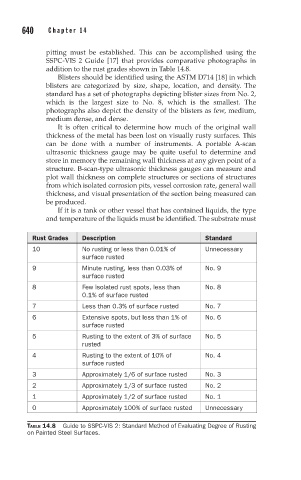Page 686 - Corrosion Engineering Principles and Practice
P. 686
640 C h a p t e r 1 4 P r o t e c t i v e C o a t i n g s 641
pitting must be established. This can be accomplished using the
SSPC-VIS 2 Guide [17] that provides comparative photographs in
addition to the rust grades shown in Table 14.8.
Blisters should be identified using the ASTM D714 [18] in which
blisters are categorized by size, shape, location, and density. The
standard has a set of photographs depicting blister sizes from No. 2,
which is the largest size to No. 8, which is the smallest. The
photographs also depict the density of the blisters as few, medium,
medium dense, and dense.
It is often critical to determine how much of the original wall
thickness of the metal has been lost on visually rusty surfaces. This
can be done with a number of instruments. A portable A-scan
ultrasonic thickness gauge may be quite useful to determine and
store in memory the remaining wall thickness at any given point of a
structure. B-scan-type ultrasonic thickness gauges can measure and
plot wall thickness on complete structures or sections of structures
from which isolated corrosion pits, vessel corrosion rate, general wall
thickness, and visual presentation of the section being measured can
be produced.
If it is a tank or other vessel that has contained liquids, the type
and temperature of the liquids must be identified. The substrate must
Rust Grades Description Standard
10 No rusting or less than 0.01% of Unnecessary
surface rusted
9 Minute rusting, less than 0.03% of No. 9
surface rusted
8 Few isolated rust spots, less than No. 8
0.1% of surface rusted
7 Less than 0.3% of surface rusted No. 7
6 Extensive spots, but less than 1% of No. 6
surface rusted
5 Rusting to the extent of 3% of surface No. 5
rusted
4 Rusting to the extent of 10% of No. 4
surface rusted
3 Approximately 1/6 of surface rusted No. 3
2 Approximately 1/3 of surface rusted No. 2
1 Approximately 1/2 of surface rusted No. 1
0 Approximately 100% of surface rusted Unnecessary
TABLE 14.8 Guide to SSPC-VIS 2: Standard Method of Evaluating Degree of Rusting
on Painted Steel Surfaces.

